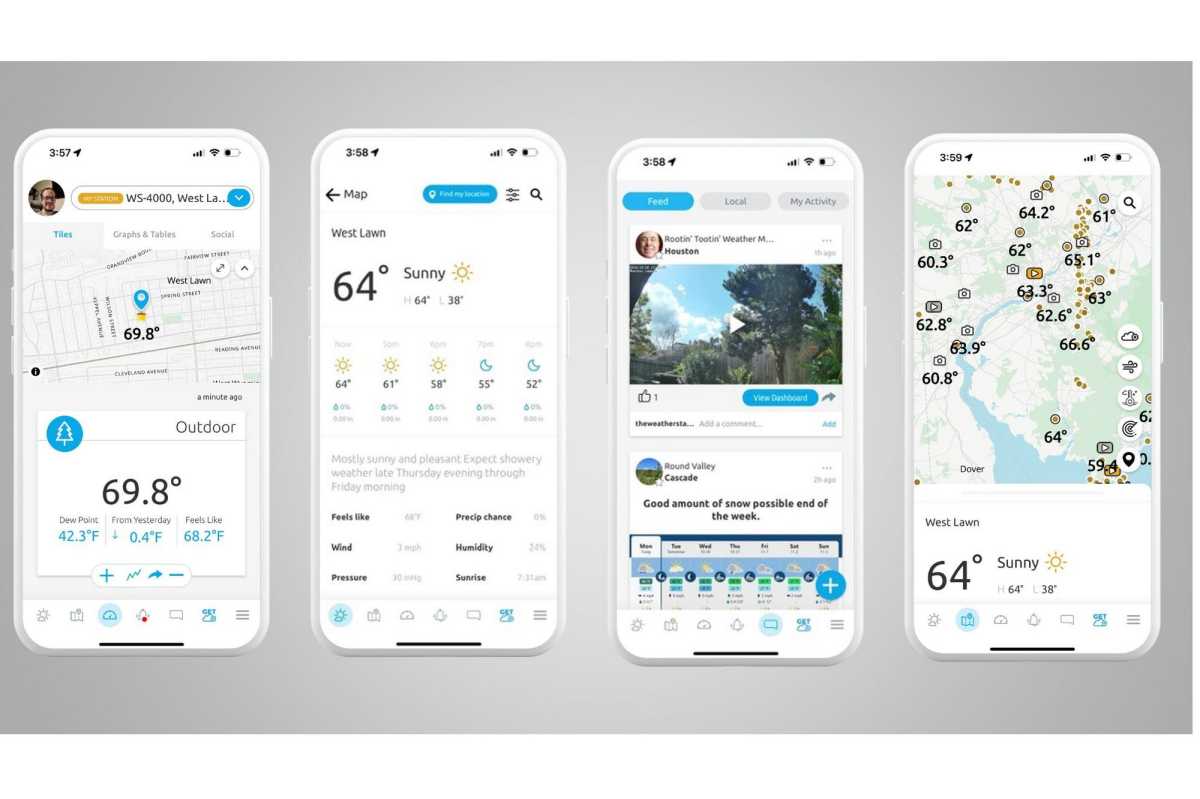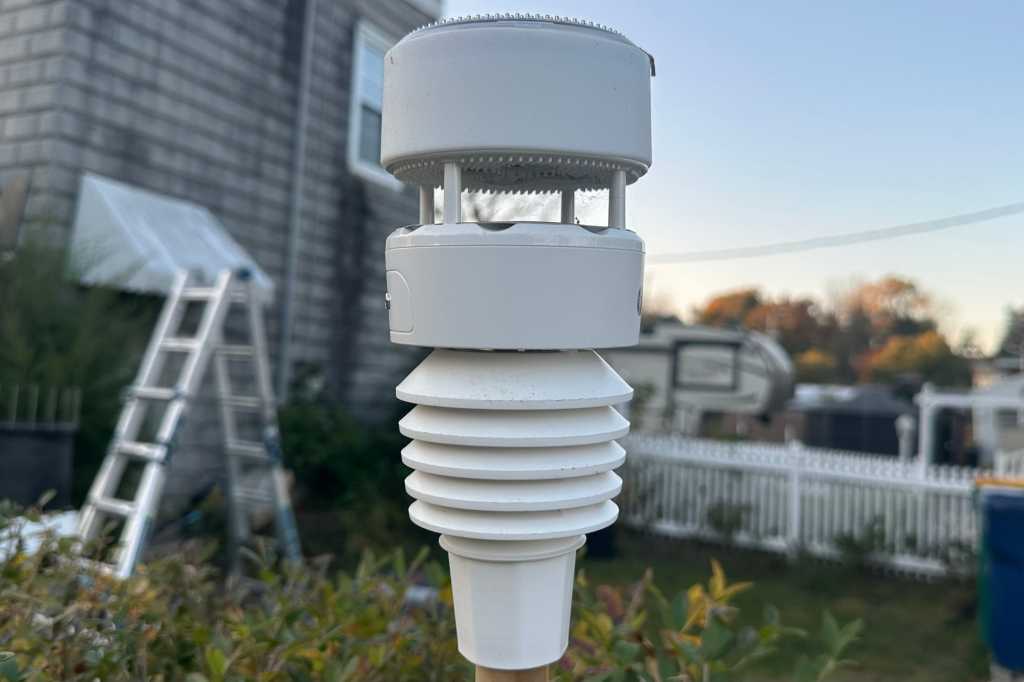Expert’s Rating
Pros
- Accurate temperature, humidity, and wind readings
- Extremely compact design
- Includes discrete thermometer-barometer-hygrometer to monitor indoor conditions
Cons
- Uses a non-standard mast size (1.0-inch vs. typical 1.25 inches)
- Haptic rain gauge is no more accurate than that of the WeatherFlow Tempest
- Not much better overall than the less-expensive Ecowitt Wittboy Pro
Our Verdict
This is a great home weather station, and Ambient Weather’s software and weather network are hard to beat, but the Ambient Weather WS-4000 is otherwise identical to the less expensive Ecowitt Wittboy Pro. And both products have problematic haptic rain sensors.
Price When Reviewed
This value will show the geolocated pricing text for product undefined
Best Pricing Today
Price When Reviewed
$369.99
Best Prices Today: Ambient Weather WS-4000
$369.99
The haptic rain sensor on the WeatherFlow Tempest was unique when I reviewed the home weather station for TechHive four years ago. But like everything in tech, other manufacturers quickly went about aping the design. The Ambient Weather WS-4000 reviewed here is just one example, although Ambient Weather didn’t do the aping directly.
That was the work of Fine Offset Electronics, which incorporated a remarkably similar device into the sensor suites for its Ecowitt Wittboy series of weather stations. Ambient Weather’s parent company Neilsen-Kellerman similarly licensed Fine Offset weather station designs to build its Ambient Weather WS-1965, WS-2902, and WS-5000 (and is now co-branding the latter two models with AccuWeather). The WS-4000 itself is identical to the Ecowitt Wittboy Pro.
The temperature, humidity, and sonic anemometer on the Ambient Weather WS-4000 performed beautifully.
Over time, it’s been discovered that haptic rain sensors aren’t as accurate as some other types. The WeatherFlow Tempest’s accuracy has improved, but it’s still inaccurate in heavy rain. I don’t think Fine Offset has solved the issue either. A description of the Wittboy-series weather stations on Amazon reads “rain drop size and wind speed can have different impacts on the sensor output…. If you are very demanding on rain data accuracy, we recommend you purchase [the] WH40 [rain gauge].” That Ecowitt accessory costs an additional $50.

This close-up view of the sonic anemometer and haptic rain gauges of the WeatherFlow Tempest (left) and Ambient Weather WS-4000 reveal their similarities.
Ed Oswald/Foundry
That doesn’t bode well for the WS-4000, and its sensor design doesn’t appear as polished as what you’ll get with the WeatherFlow Tempest. But looks aren’t everything, and the WS-4000 comes bundled with a in-home console, where you’ll need to roll your own with something like a Raspberry Pi—or just use WeatherFlow’s app on your phone—if you buy the Tempest. On the third hand, the WS-4000 costs more. And at the risk of complicating your purchase decision even further, the Ecowitt Wittboy also comes with an in-home console—for less money than either of those weather stations. While we haven’t laid hands on that product, it bears repeating that the WS-4000 is based on its design.
Specifications
The Ambient Weather WS-4000 is an all-in-one sensor suite, with no moving parts. As we’ve already established, it follows the same design as the WeatherFlow Tempest, with temperature and humidity sensors on the bottom and a sonic anemometer on top that looks very similar to the one found on the $450 Ambient WS-5000 I reviewed in early 2021, except it’s taller. This is where the haptic rain, UV, and light sensors are located.
Ambient Weather bundles its WH32B Thermometer-Barometer-Hygrometer with the WS-4000, so you can monitor your indoor climate conditions, which you won’t get with the Tempest, but you won’t get a lightning sensor like you do with WeatherFlow’s product. The Wittboy integrates thermometer, barometer, and hygrometer into its console, but it doesn’t have a lightning sensor.

The console that comes with Ambient Weather’s WS-4000 is bright and readable from a distance.
Ed Oswald/Foundry
Like other Ambient Weather stations, the WS-4000 uses the Ambient Weather Network for network connectivity. The service is free, but if you want up to three years of historical data and additional map layers, you’ll need to sign up for a $50-per-year subscription.
Installation and setup
The WS-4000 is simple to set up, which is good because it doesn’t come with a full user manual, just a quick-start guide. And that’s fine, with one exception: Every recent weather station I’ve reviewed mounts to 1.25-inch antenna mast. I was surprised to discover that this one needs a 1-inch mast.
Since I’m only testing the station for a short period, I grabbed a 1-inch wooden dowel from Home Depot for the job. The need for a 1-inch mast won’t be a pleasant surprise for anyone replacing an existing weather station, and Ambient Weather should disclose this prominently in its product descriptions.
Since the WS-4000 comes with a console and that indoor sensor, setting it up involves a few more steps; you’ll also need to install two AA batteries (included) in the sensor suite for backup power (there’s a solar panel on top of the station).
The Ambient Weather Network app is great

The AWN app features a clean user interface that is easy to navigate. It hasn’t changed much over the past few years.
Ambient Weather
The Ambient Weather app and smart home support are why we recommend these home weather stations for the connected home. Ambient Weather Network service is free, and you can use either IFTTT or Amazon Alexa (Google Home is no longer supported because Google changed its API, which would require a wholesale rewrite of the AWN platform to restore compatibility. Ambient Weather has said it does not plan to do that.)
I’ve discussed the Ambient Weather app in detail in other Ambient Weather stations. Not much has changed, so I’ll refer you to my Ambient Weather WS-5000 review if you want to read more about it.
Solid sensor performance (apart from the rain gauge, that is)
The temperature, humidity, and sonic anemometer on the Ambient Weather WS-4000 performed beautifully. Sonic anemometers are much more sensitive, and in my opinion, more accurate than the traditional cup and vane. A sonic anemometer’s accuracy suffers as wind speed increases, but most people will never need to worry about it. That’s because this type of gauge maxes out at a higher speed than most of us will never experience: about 85 mph.
The WS-4000’s small footprint also makes it less conspicuous in your yard. The KestrelMet 6000 in my yard sticks out like a sore thumb, where the WS-4000’s small size allows it to blend in (even better than the slightly larger Tempest).
Ambient Weather’s higher-end console also allows you to add additional sensors, and there are quite a few to choose from. The console should automatically detect any that you add and automatically display their readings data. That was my experience this time arouond, although I’ve had mixed results with my reviews of other Ambient Weather stations.
A haptic rain sensor falls short—again
As for the Ambient Weather WS-4000’s haptic rain gauge: I wish I had better news, but this iteration is no better than any of the previous haptic designs I’ve reviewed. The rain gauge couldn’t measure rainfall correctly unless the top of the sensor suite was perfectly level. And just like the Tempest, the WS-4000 doesn’t perform well in light rain or drizzle, which is what I experienced during my tests.
Using haptic sensors to measure rainfall seems like a great idea in theory; in practice, haptic rain sensors have just proven to be too inaccurate too often. That said, if you can deal with rainfall measurements that aren’t the most accurate, every other aspect of this home weather station is excellent.
Should you buy the Ambient Weather WS-4000?
I will test the Ambient Weather WS-4000 over the long term, just as I have the Tempest; in fact, the station is now headed to the West Coast—just in time for their rainy season. This will be a great opportunity to see if my experience with its haptic rain sensor is what buyers should expect.
For now, I can recommend the WS-4000 most heartily to owners of lesser Ambient Weather stations who are looking to step up to something better without changing platforms (that’s a pain you won’t want to deal with). If you’re looking to buy your first weather station, be sure to also consider the Ecowitt Wittboy Pro. It bears repeating that I haven’t personally tested that product, but it is based on the same design and it costs $70 less.

